- Optimization of multi passes friction stir process parameters on AA7075 Surface Hybrid Composite with reinforcement of SiC and Gr
Periasamy Ka,*, Sivashankar Nb, Viswanathan Rc and Balaji Jd
aDepartment of Mechanical Engineering, Kongunadu College of Engineering and Technology, Trichy, Tamilnadu, India
bDepartment of Mechanical Engineering, Kongunadu College of Engineering and Technology, Trichy, Tamilnadu, India
cDepartment of Mechanical Engineering, AVS Engineering College, Salem, Tamilnadu, India
dDepartment of Mechanical Engineering, Erode Sengunthar Engineering College, Erode, Tamilnadu, IndiaThis article is an open access article distributed under the terms of the Creative Commons Attribution Non-Commercial License (http://creativecommons.org/licenses/by-nc/4.0) which permits unrestricted non-commercial use, distribution, and reproduction in any medium, provided the original work is properly cited.
High strength and less in weight has evidenced the high application of Aluminum 7075 in industry. Present research of Aluminum 7075 has highly aimed for surface modification for better wear rate and friction resistance. This work is particularly carried out to modify the surface of aluminum 7075 with high mechanical properties and wear for high strength applications. The work contains development of AA7075 T6 with prearranged compositions of SiC & Gr by using Friction stir processing. First, Fabrication of AA7075 with 10wt.% of SiC and 5wt.% of Gr was done with single, double and triple pass technique. Secondly, Different tests were carried out to identify suitable material fabrication technique and mechanical characteristics. Based on the experimental results, 3pass FSP AA7075/SiC & Gr specimen offered better results with 156HV hardness, 268MPa tensile stress were found and process parameters are optimized
Keywords: Aluminum, Friction Stir Processing, Wear Resistance, Friction, GRG
Aluminum 7075 metal matrix composites offers High strength, hardness and excellent stiffness for various industrial applications and at the same time, corrosion resistance and wear resistance are the major concern. For betterment of wear rate and friction behavior, different combinations of reinforcement, ceramics and particles are under consideration.
Due to huge application scope, improved surface quality in aluminum alloy needs investigated. Preparing metal matrix composites (MMCs) for various applica- tions is the traditional approach for the development of new metal [1-4]. Instead of preparing the new MMCs, modifying the surface of existing alloy is an exciting approach. For modifying the surface, friction stir pro- cessing (FSP) is preferable. Single FSP is performed with shoulder and pin which leads to base metal plastic deformation while using with reinforcements [5-7].
Silicon carbide (Sic) attracted many researchers due to minimum density, good chemical inertness and better hardness. It results high micro hardness, when added with aluminum 7075 [8]. Addition of SiC with graphite reinforcement in AA7075 indicates loss in friction. Prabhakar et al. [9] conducted the properties investigation in Al7075 along with fly ash and E-glass by fluid procedure strategy. The experimental results shown that, betterment of tensile and compression strength in Al7075. Baradeswaran et al. [10] studied tribological properties of Al7075- Al2O3 with the re- inforcement of 5 wt.% of Gr. They stated that, hardness is raised when addition of Gr various from 5-20 wt.% as reinforcement on Al2O3. Reinforcement of 10% Al2O3 with aluminum 6061 results high coefficient of friction and wear [11]. Development of Surface MMCs with FSP results significant dominance in aluminum alloy [12-15]. For better particle distribution, high tool speed and minimum tool travel are the optimum parameter. However, this is not suitable for single pass FSP technique. In single pass FSP technique, the re- inforcement is dispersed in base matrix material [16-18].
Prabhu et al. [19] fabricated the AA6062 with SiC surface hybrid composite by multi pass technique. Based on the research, the fabricated 3 pass AA6062 specimen dominated in all the aspects compare to 1 pass and 2 pass specimen. Significant improvement was noted in mechanical behavior and microstructure. Hence surface modification in FSP technique offers adequate results compare to other techniques [20-22]. Khodabakhsh et al. [23] noted that, hardness of alu- minum alloy raised when the specimen is made up to FSP technique. Improvement in hardness was noted when the tool travel pass is raised from one to three. Homogeneous distribution of reinforcement particle on the base metal was also noted. Prabhu et al. [24] identified the wear and friction parameter of Al6082 with CaCO3 surface hybrid composite by FSP technique. Improvement in friction and wear was observed. It single pass technique, the friction and wear was improved by 2%. Generally, fabrication of surface hybrid specimen in FSP is influenced by tool travel speed and selection of tool [25-28]. Proper selection of FSP tool controls the escapement of reinforcement particle from the grooves. Addition of SiC and Gr in AA7075 results better output, addition of 5 wt.% Gr increases the wear resistance by 170 to 340 times [19, 29]. Though increas- ing the Gr reinforcement beyond 5%, fracture toughness is decreased [30]. Mixture of hard particle like SiC and Soft Gr induced better composition and good results [31-33]. Tamilanban et al. performed GRA optimization with Al-SiC composite fabricated by stir casting method [34]. They noticed hardness and ultimate tensile strength is increased due to addition of SiC particle. Frictions stir method commonly used in material joining and surface modification [35-36].
Based on the past study, research works was concen- trated mostly in reinforcement mixture and method selection. In FSP, many research works was done with various compositions of reinforcements. With reference to past study, Fabrication of AA7075/SiC and Gr re- inforcement with multi pass technique was not done in Friction stir processing. In this paper, fabrication of sur- face hybrid composite with SiC and Gr added as the re- inforcement was planned and its mechanical characteristics were investigated. For preparing specimen, 5 wt.% of Gr and 10 wt.% of SiC was used as reinforcement. The reinforcement wt.% is selected based on detailed litera- ture study. Finally, FSP process parameters are optimized with multi objective optimization technique.
Aluminum 7075 alloy
AA7075 aluminum alloy with 150 x 75 x 6 mm is used for this experiment. The material composition of AA7075 is presented in Table 1.
Processing Technique
The technical sketch of multi pass friction stir pro- cessing is shown in Fig. 1.
The FSP machine is used for fabrication of AA7075 alloy is controlled by three axis servo setup. For making specimen, 1500 rpm spindle speed and feed rate 40 mm/min is used. A groove of 2 mm width and 2.4 mm depth is made to deposit SiC and Gr particles. 5 wt.% of Gr and 10 wt.% of SiC is mixed and used as a reinforcement. The average size of SiC and Gr particle used in this study is about 50 µm. EN31 square hardened pin with the dimensions of shoulder diameter 21 mm and 4.5 mm pin length is used to fabricate AA7075 surface hybrid composite. Pin type and non-pin type tool is selected for processing. Non pin type tool is mainly used for reduce the escapement of SiC and Gr particle from the grooves and pin type of tool is used for processing and reinforce the particle with the base metal. Fig. 2 and Fig. 3 indicates the experimental setup and processed samples of AA7075/SiC & Gr surface hybrid composites.
Hardness test
Vickers model of micro hardness tester is used for determining the micro hardness of AA7075 with SiC & Gr surface hybrid composite. The load applied on the samples is 300 g and dwell time is 15 sec. Average Hardness is taken into account and it is measured at the processed zone.
Tensile test
Universal Testing machine (UTM-INSTRON) is used for carryout the tensile test and ultimate tensile strength of AA7075/SiC and Gr is determined.
Friction and wear test
Pin on disc tribometer is used for the study of wear and friction in AA7075/SiC & Gr surface hybrid composites. The required samples are shaped with the dimensions of 6 ´ 6 mm diameter and depth respec- tively. For wear test, steady load of 15 N with sliding velocity of 1 m/s and sliding distance of 1300 m were used.
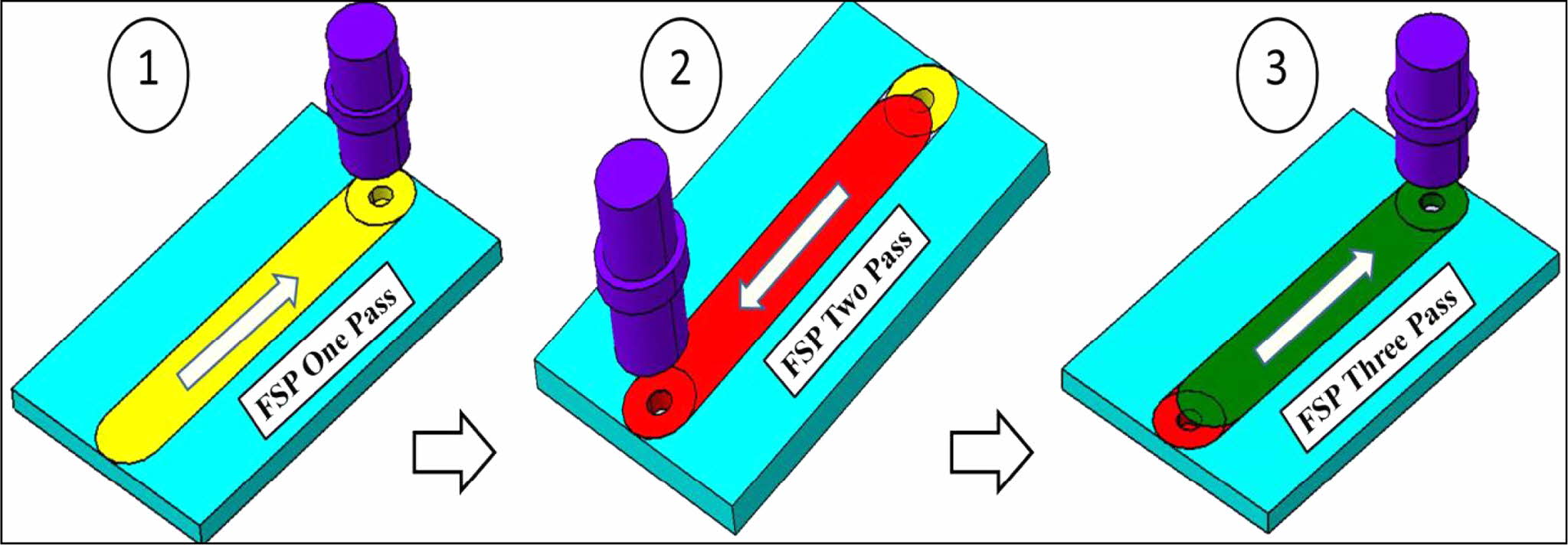
|
Fig. 1 Technical sketch of multi pass friction stir processing. |
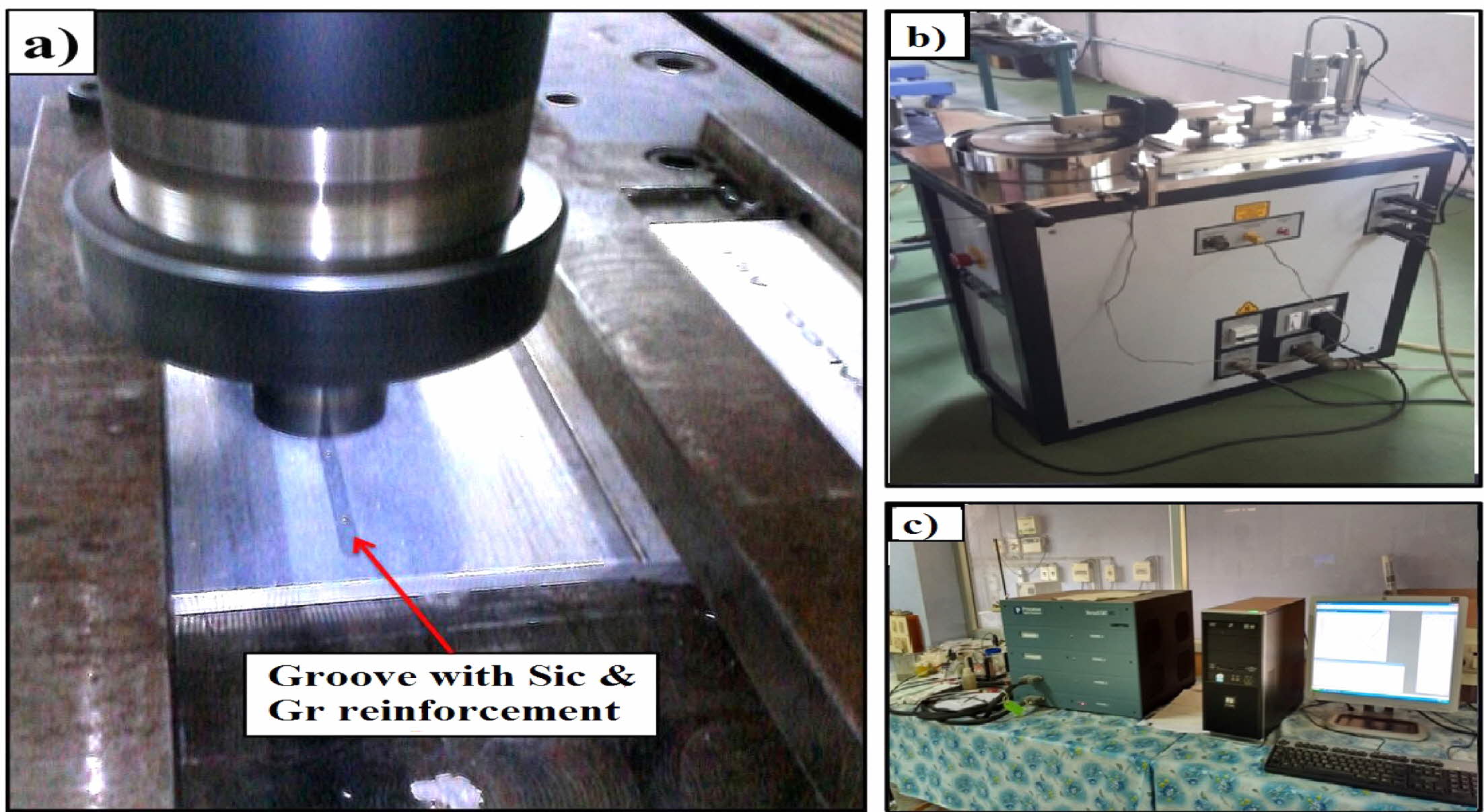
|
Fig. 2 Experimental setup: (a) FSP machine, (b) Pin on disc tribometer and (c) SEM Analysis. |
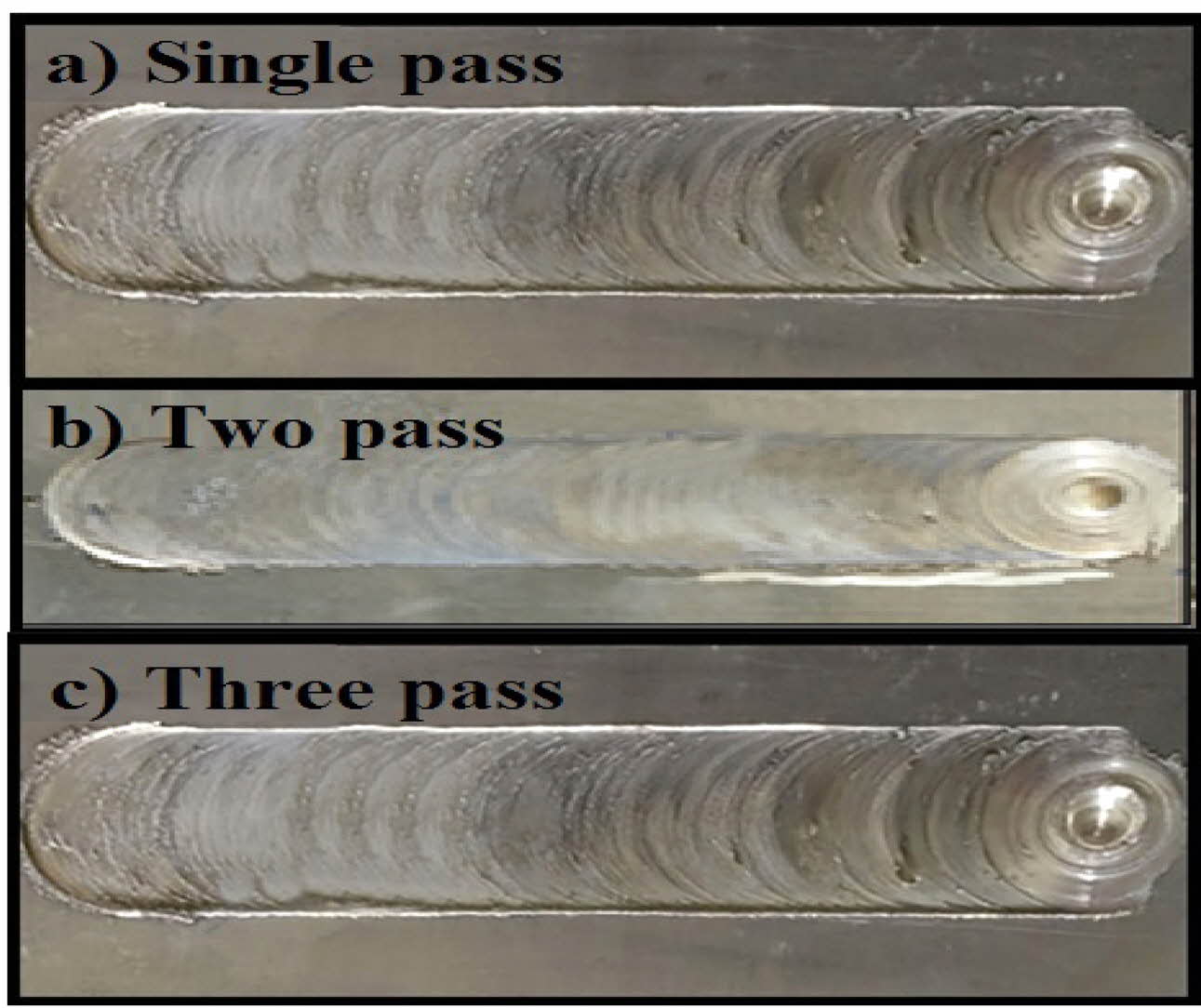
|
Fig. 3 Processed samples of AA7075/SiC & Gr surface hybrid composites |
Micro hardness
The micro hardness of AA7075/SiC & Gr is calcu- lated and shown in Fig. 4. From the Fig. 4, it is evident that the average micro hardness gradually increases at processed zone (Nugget Zone - NZ) from the base material. The maximum hardness of 156 HV is obtained in three pass AA7075/SiC and Gr compared to the base material AA7075 alloy (63HV). This is due to fine grain refinement and more density dislocation. From the experimental results, it is noted that the micro hardness gradually mounting i.e., 128 HV, 140 HV and 156 HV for 1 pass, 2 pass and 3 pass of AA7075/SiC & Gr respectively. This is due to incorporation of AA7075 with SiC and Gr with respect to Hall-Petch effect. The hardness of 3 pass AA7075/SiC & Gr is much better than other two specimens. This indicates the material flow and dispersion of article reinforcement is better compare to 1pass and 2 pass FSP AA7075/SiC & Gr. Formation of cluster is very less in 3 pass FSP AA7075/SiC & Gr and hence its hardness is higher. This result is verified with prabhu et al. [19]. Hardness is highly depends on cluster formation in friction stir processed specimen [20]. Due to homogeneous disper- sion of SiC & Gr with AA7075 alloy, minimum cluster particle and coarse grain gotten in 3 pass processed AA7075/SiC/Gr specimen and maximum micro hardness is obtained.
Tensile Test
The tensile behavior of fabricated AA7075/SiC & Gr is shown in Fig. 5 and ultimate tensile strength (UTS) is plotted in Fig. 6. Based on the investigation, it is noted that, the tensile strength of base material AA7075 is 198 MPa. Similarly, the ultimate tensile strength for 1 pass, 2 pass and 3 pass FSP AA7075/SiC & Gr sample are 225 MPa, 251 MPa, and 268 MPa respectively. It is noted the ultimate tensile strength of FSP AA7075/SiC & Gr is 26.12% higher than the base material AA7075. The reinforcement of silicon carbide particle and graphite in AA7075 material leads the improvement in tensile strength. Due to the lower density of graphite, it produced pit less reinforcement on base material and reduction in material elongation. The results are compared and it is much nearer with khodabakshi et al. [23]. The material elongation of AA7075/SiC & Gr are follows; 25.3% for base material, 10.01% for 1pass sample, 15.4% for 2 pass sample and 20.3% for 3 pass sample. When number of passes increases, uniform dispersion of SiC & Gr particle take place in AA7075 and hence increase in UTS is obtained.
Based on SEM analysis, the fractured surface was investigated. From the Fig. 7 it is evident that, particles spread out is takes place at 1 pass FSP AA7075/SiC & Gr. It is observed that formation of cluster affected the interface bonding with AA7075. Due to large grain size and improper bonding, less tensile strength was attained. Increase in passes results improvement in tensile strength [19]. It is proved that, significant relation between FSP processing and tensile strength of the specimen [20]. Homogeneous distribution of grains and refinement seen in 3 pass FSP specimen and it controls the presence of voids in the specimen. Good interfacial bonding between SiC & Gr with AA7075 was seen and it results the high tensile strength in 3 pass AA7075/SiC & Gr sample.
Surface roughness
Taylor Hobson roughness tester (S128M) model is used to measure the surface roughness in AA7075/SiC and Gr composite. The presence of SiC and Gr over the AA7075 has major influence on surface roughness. Higher number of passes results reduction in surface roughness. Maximum surface roughness of 6.047 µm is obtained in 1 pass FSP AA7075/SiC & Gr sample. For 2 pass and 3 pass sample, 3.028 µm and 1.320 µm is obtained respectively. It indicates that, the roughness value is reduced up to 78.17%. Due to particle escape- ment and improper mixing, grimness has occurred in 1pass FSP AA7075/SiC and Gr surface. Hence this grimness induced high surface roughness in 1 pass FSP AA7075/SiC and Gr sample. At the same time, roughness value is gradually reduced while increase in passes. Low density Gr particle induced the dispersion in AA7075 and it minimizes the grimness on the surface. In 3 pass FSP AA7075/SiC & Gr, the roughness value is further reduced due to homogeneous scattering of SiC and Gr particle over the AA7075 alloy. It results low roughness and grimness in 3pass FSP AA7075/SiC and Gr surface hybrid composite.
Friction and wear analysis
Friction and wear test is conducted in pin-on-disc tribometer under dry condition using EN31 steel tool and its results are plotted in Fig. 9. and Fig. 10. From the investigation, base material AA7075 induces less coefficient of friction than other samples. This is due to less Ra, plastic deformation and soft sliding is occurred in AA7075. COF value is increased suddenly in 1pass FSP AA7075/SiC & Gr composite due to the harshness of AA7075/SiC & Gr surface [32-34]. Reduction in Ra, equivalent scattering of SiC and Gr particle and minimum grain size are the major reason for minimum COF in 3 pass FSP AA7075/SiC & Gr composite. Due to harshness surface, high friction is occurred in 1 pass & 2 pass AA7075/SiC & Gr composite and hence high stress induced. Due to high friction, debris also stayed in the track that results high coefficient of friction in 1 pass and 2 pass FSP AA7075/SiC and Gr surface hybrid composites.
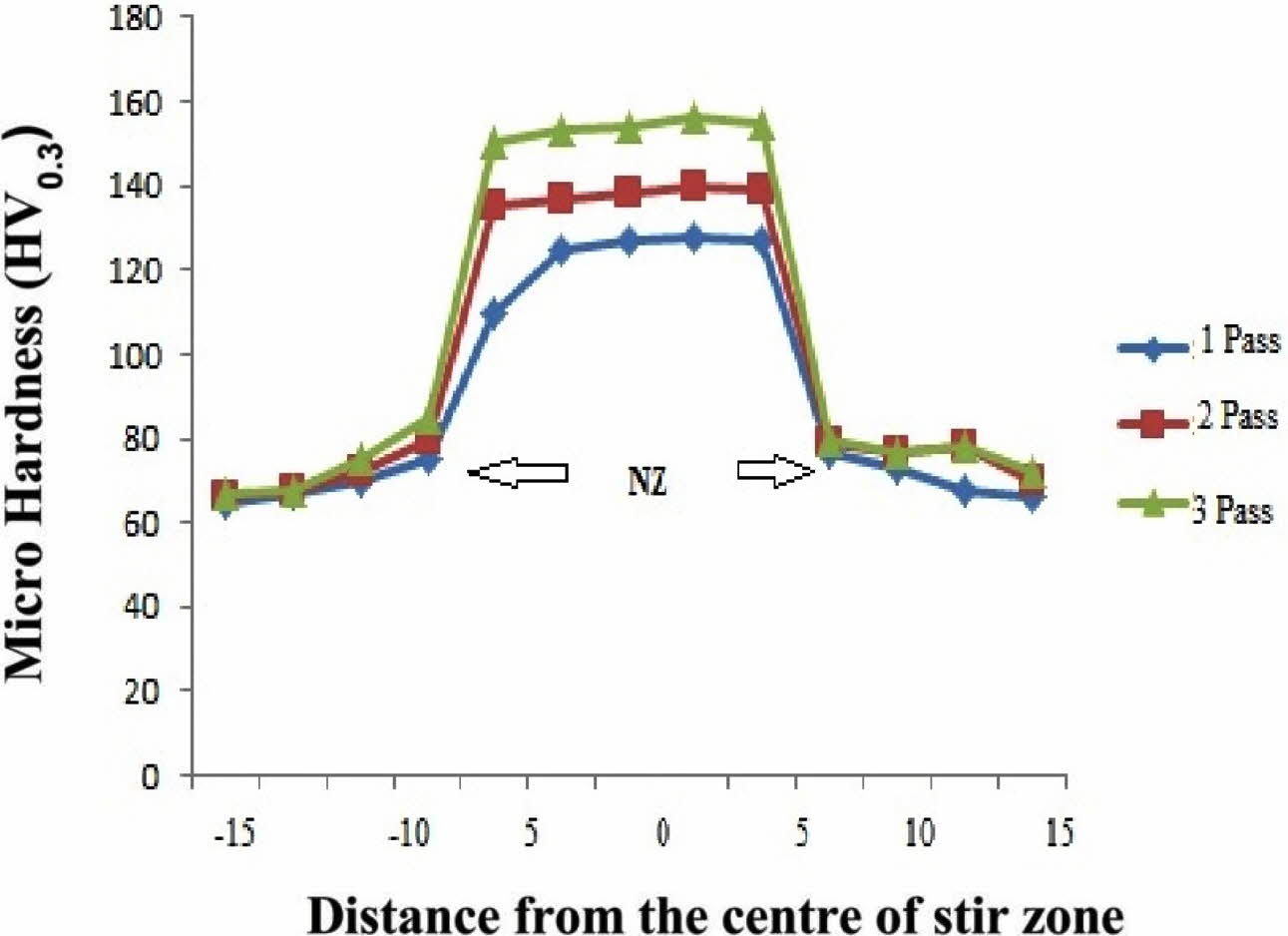
|
Fig. 4 Micro hardness of FSP AA7075/SiC & Gr at different condition |
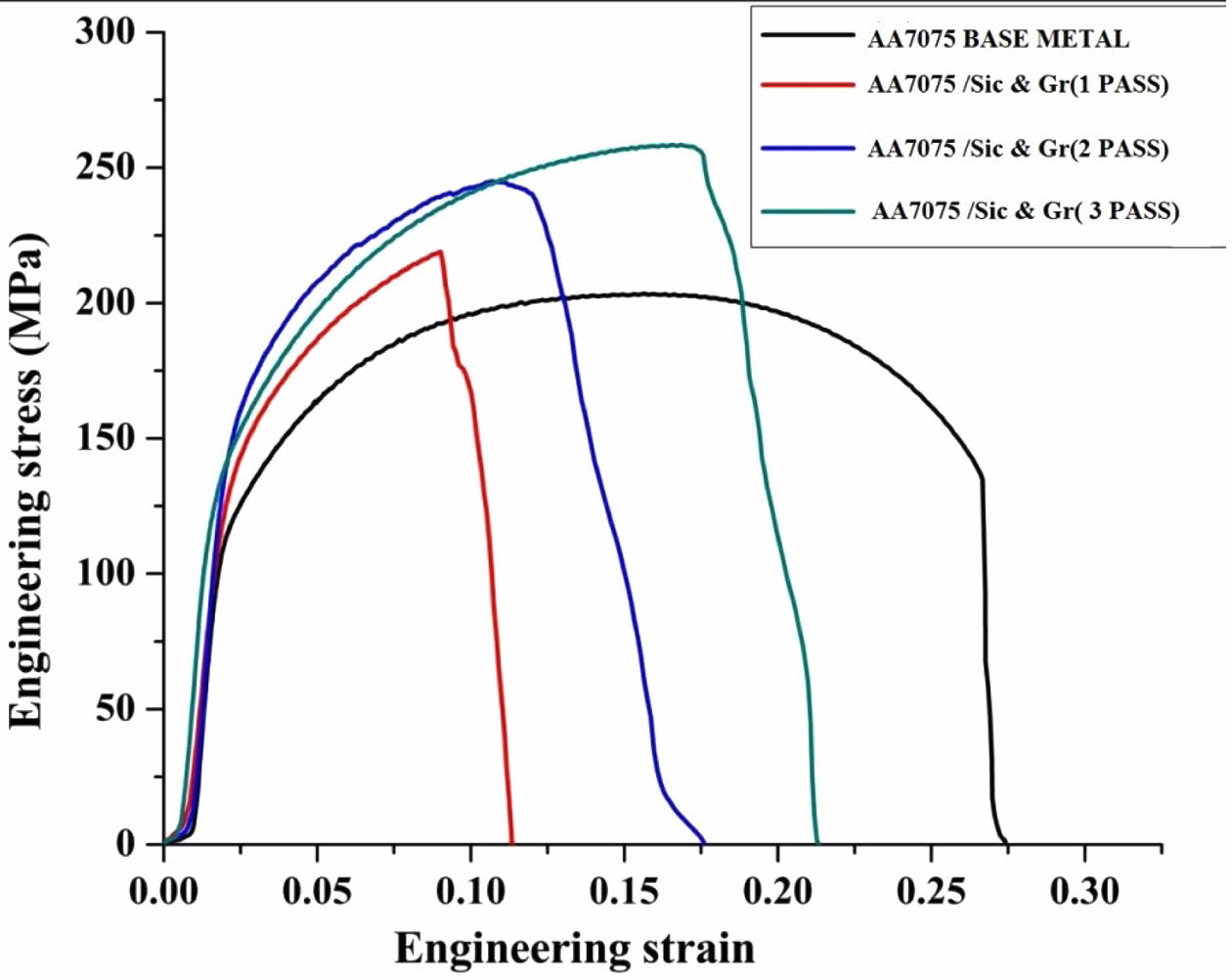
|
Fig. 5 The tensile behavior of fabricated AA7075/SiC & Gr. |
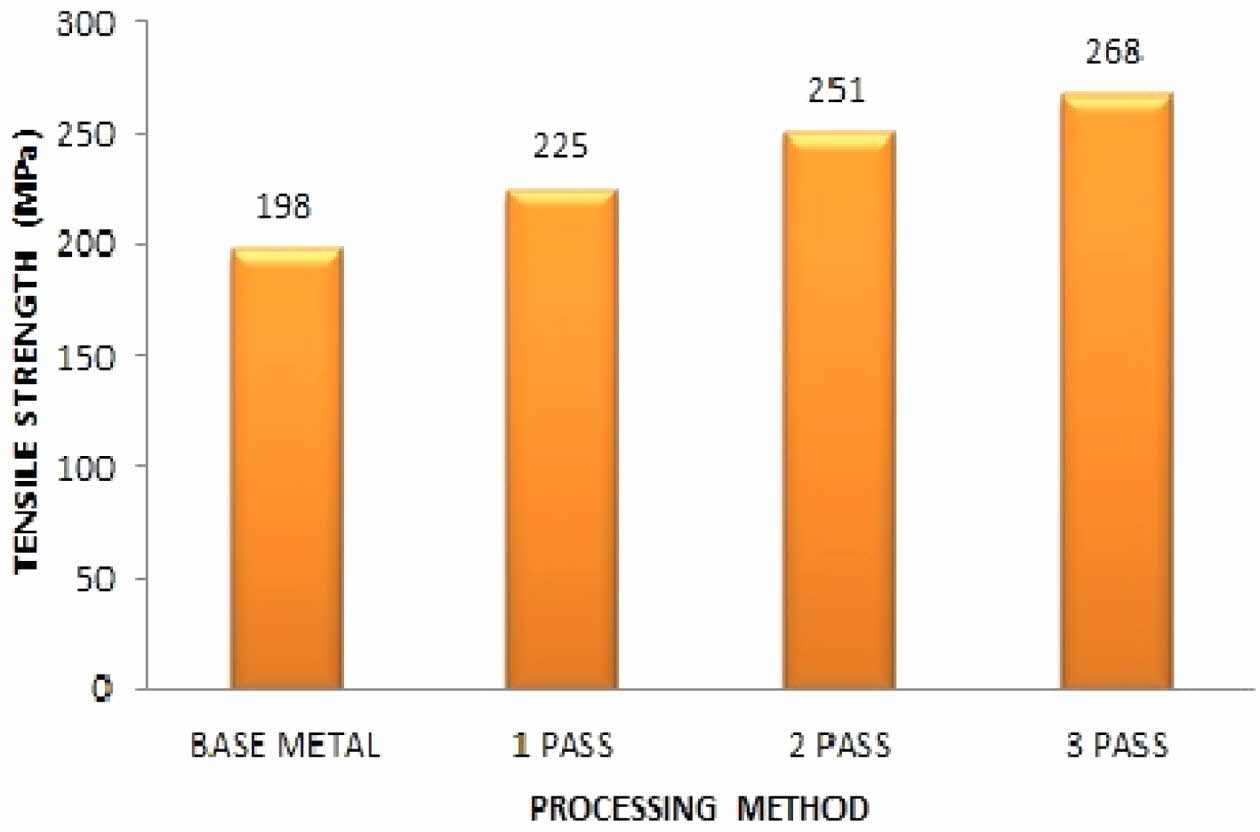
|
Fig. 6 Ultimate tensile strength (UTS). |
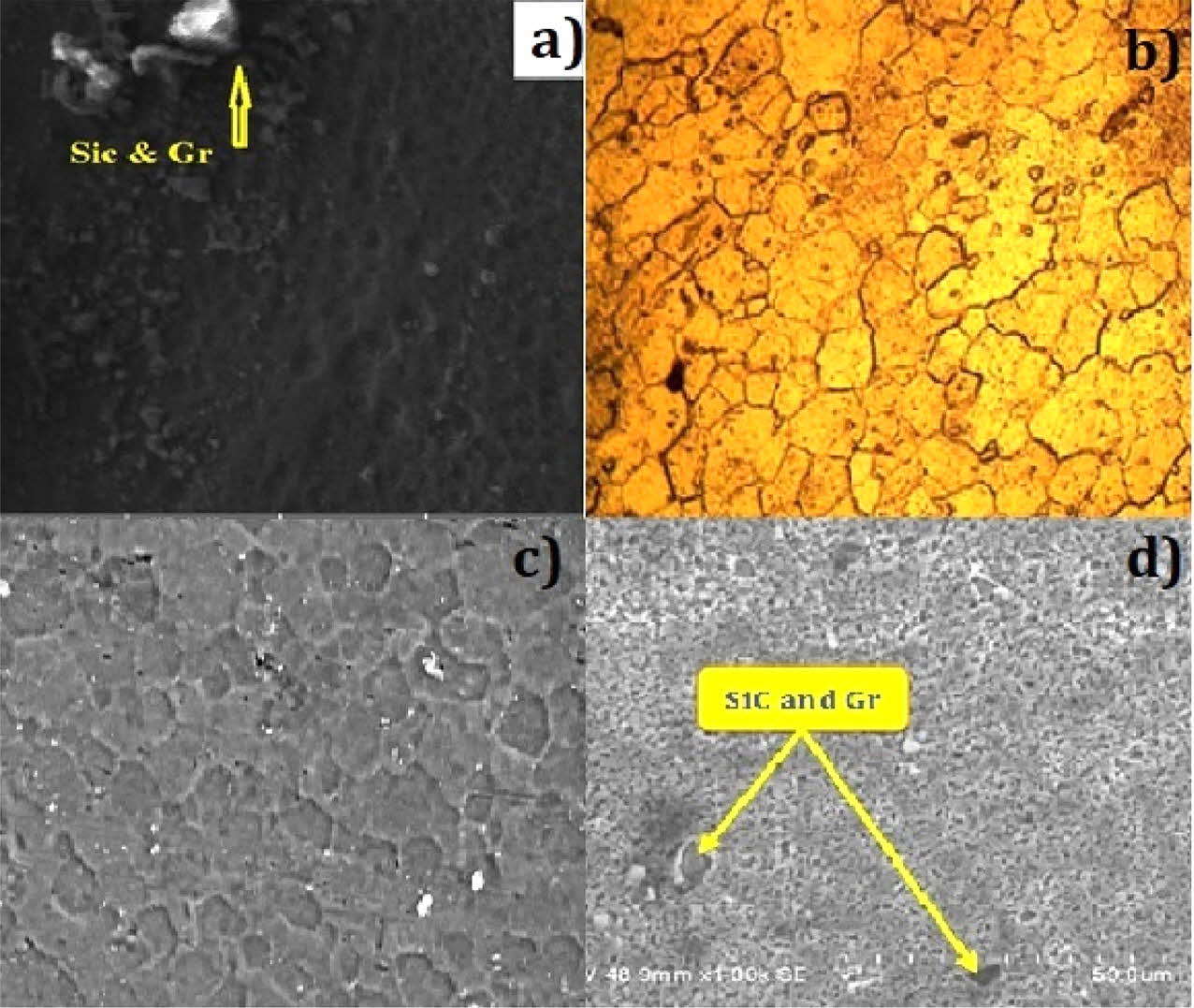
|
Fig. 7 SEM analysis of (a) 1 pass 777075/SiC & Gr, (b) Cluster affected Surface Morphology, (c) 3 pass 777075/SiC & Gr, and (d) Homogeneous distribution of grains and refinement in 3pass FSP specimen. |
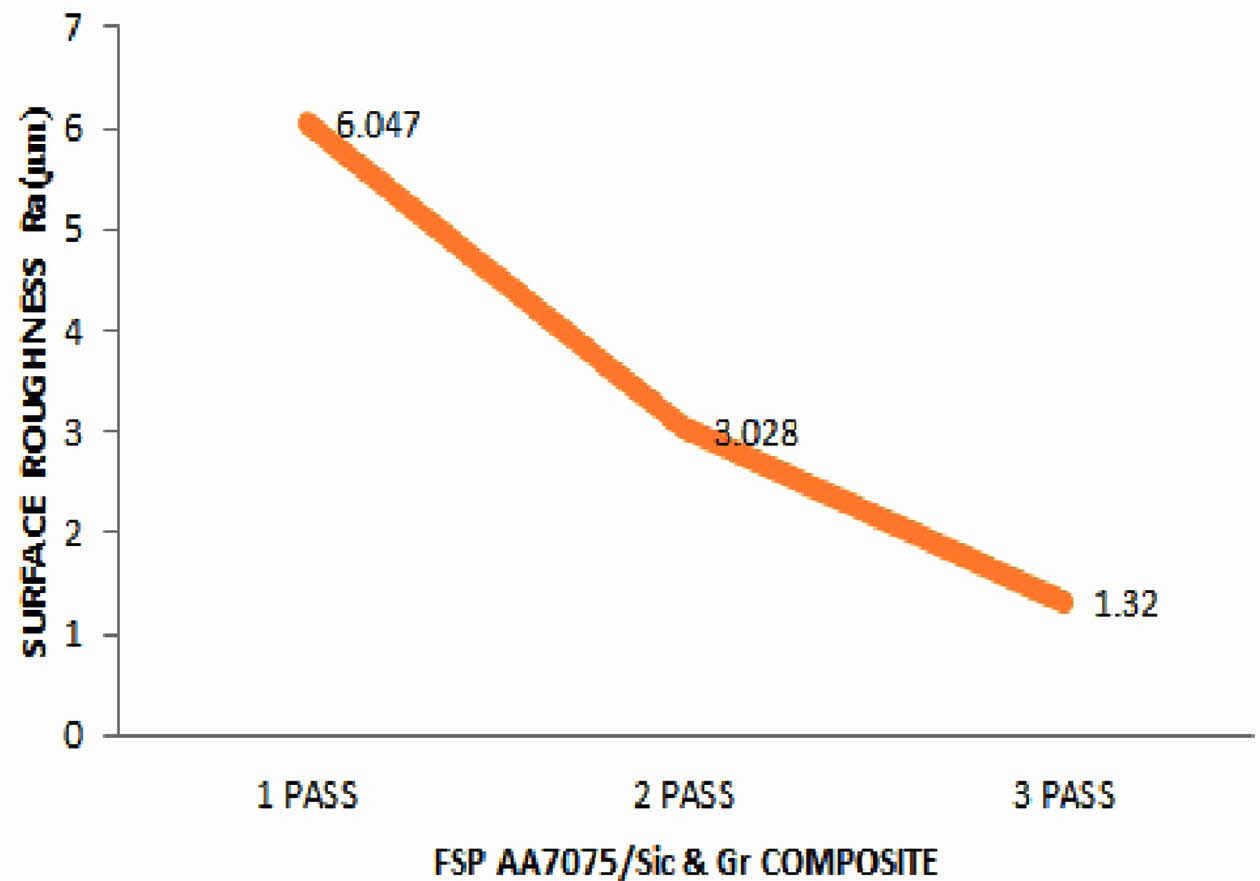
|
Fig. 8 Surface Roughness of FSP AA7075/SiC & Gr composites. |
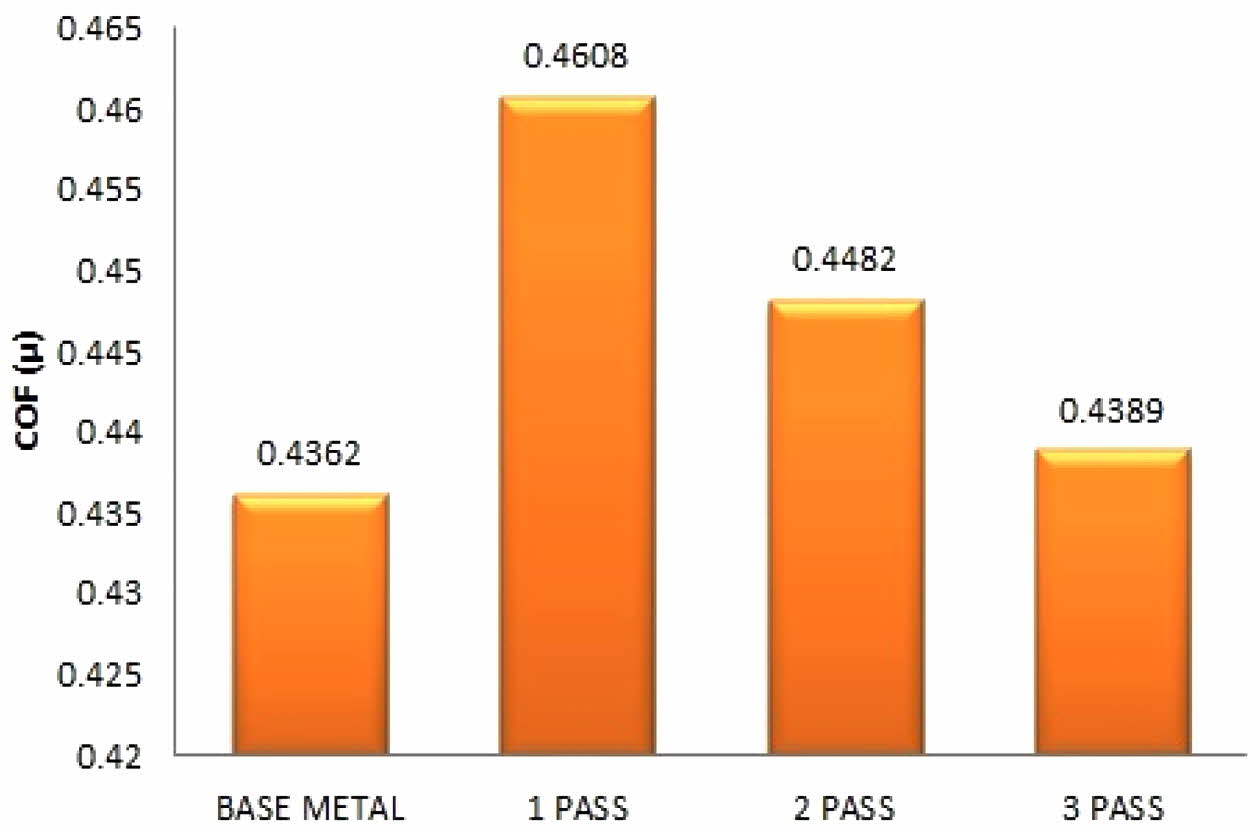
|
Fig. 9 Coefficient of Friction at various passes. |
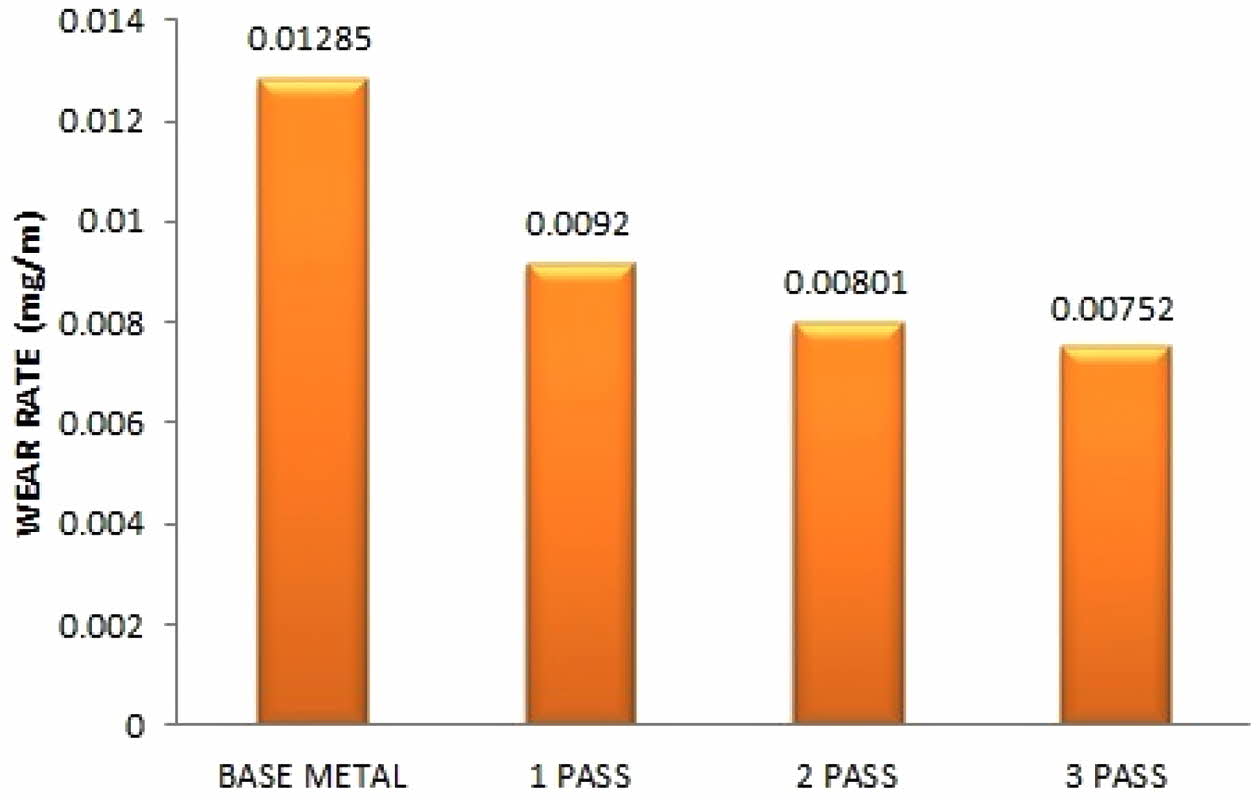
|
Fig. 10 Wear rate of FSP AA7075/SiC & Gr composite. |
Based on the preliminary experiments, 3 pass FSP pro- vides impressive results compare to single and double pass FSP specimen. Hence for obtaining better reinfor- cement wt.% and better output in 3 pass specimens, Gr is kept as constant. Parameters for conducting experi- ments were plotted in Table 2. L16 DOE was preferred and experimental results are given in Table 3.
Grey Relational Analysis
Taguchi’s optimization method reduces the experi- ment to obtain the experimental information and leads to time reduction. With respect to signal-to noise ratio, larger the better, normal the better and smaller the better methods are generally preferred. This present work aimed to obtain better 3 pass FSP Specimen with better wear and COF. So that, smaller the better is selected. Eq. (1). is used to calculate the S/N ratio [37].

where y = result of experiments.
With the help of Minitab’17 the objective function’s S/N ratio values were calculated and the results were plotted in Table 2. Grey relational analysis is one of the well-known methods amongst multiple criteria decision making grey techniques. It has one important a bene- ficial feature is the ability to measure quantitative and qualitative relationships between variables and factors using a comparatively small amount of data. The GRA was performed to determine the optimum process variables for combined multi objective of minimum wear rate and COF of the AA7075-SiC-Gr surface com- posites. Smaller is better was selected as the objective function of the wear rate and COF of the AA7075-SiC-Gr surface composites. By using the standard GRA mathematical formulas, grey relational coefficients (GRC) and grey relational grades (GRG) were obtained. The GRG can acquire the optimum combination of the control parameters, and the contribution of each experimental parameter combination. The result of S/N ratios and their delta values were used to rank the wear parameters to study their influence on the combined objective function as shown in Table 4, the combination of minimum wear rate and COF is obtained at 13th experiment for maxi- mum GRA values which indicates the best combined objective.
The mean Effects plot based on GRG indicates level one load and level four of Sic and level three of sliding velocity dominates the FSP and plotted in Fig. 11. Minimum load on material processing generally reduces the wear rate. At the same time addition of hard ceramic particle like SiC with predefined Gr induces self-lubricating property and reduces the wear rate. With the support of Table 5, it is evident that load dominates maximum level compare to addition of reinforcement and sliding velocity on wear and COF. Based on ANOVA analysis (Table 6), contribution of each process parameter on wear and COF was studied [38]. For better three pass specimen, load contributes 79.08% on wear and COF compare to other. Addition of SiC and Gr contri- butes 19.61%. Sliding velocity induces less contribution compare to load and reinforcement. Based on the multi objective optimization, confirmation experiments was performed and A1B4C3 (10N load, 15% of SiC and 3 m/s sliding velocity) found as optimum condition for achieving better surface modification as shown in Table 7. 3 Pass FSP specimens were made. 0.000102 mm3/m of wear rate and COF of 0.030 was found in the confirmation experiment. Defects free 3 Pass FSP specimen was obtained and quality is ensured with SEM morphology. SEM image of 3 Pass FSP specimen at optimized parameters is given in Fig. 12.
Similarly single objective optimization also performed to identify the individual dominance on wear and COF. SN ratio for both wear and COF was plotted in Table 8. Based on the table analysis, load dominant high on wear and reinforcement is more dominant on wear. Minimum wear rate is achived due to formation of self-lubrication while using SiC and Gr homogeneous mixture on the AA7075 surface. These results are highly matched with Prabu [24]. Mean effects plot for wear and COF was shown in Fig. 13 and 14 respectively. For optimized wear specimen, 10 N load 15% of SiC and 4 m/s sliding velocity was preferred. At the same time, for minimum friction rate, 10 N load 15% of SiC and 1 m/s sliding velocity was preferred. Based on single and multi-objective optimization, 10 N load and 15 wt.% of SiC was preferred for 3pass FSP specimen.
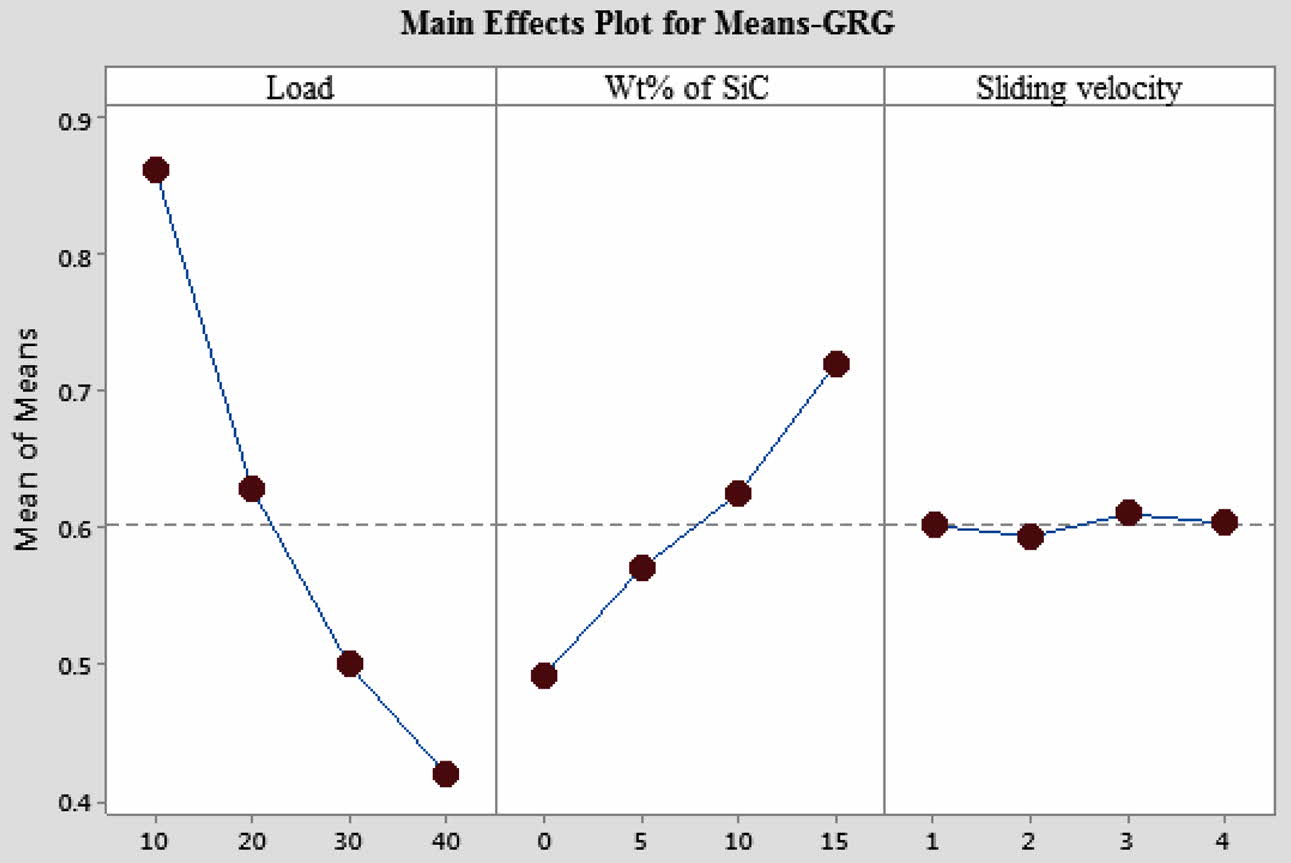
|
Fig. 11 Mean Effects plot- GRG |
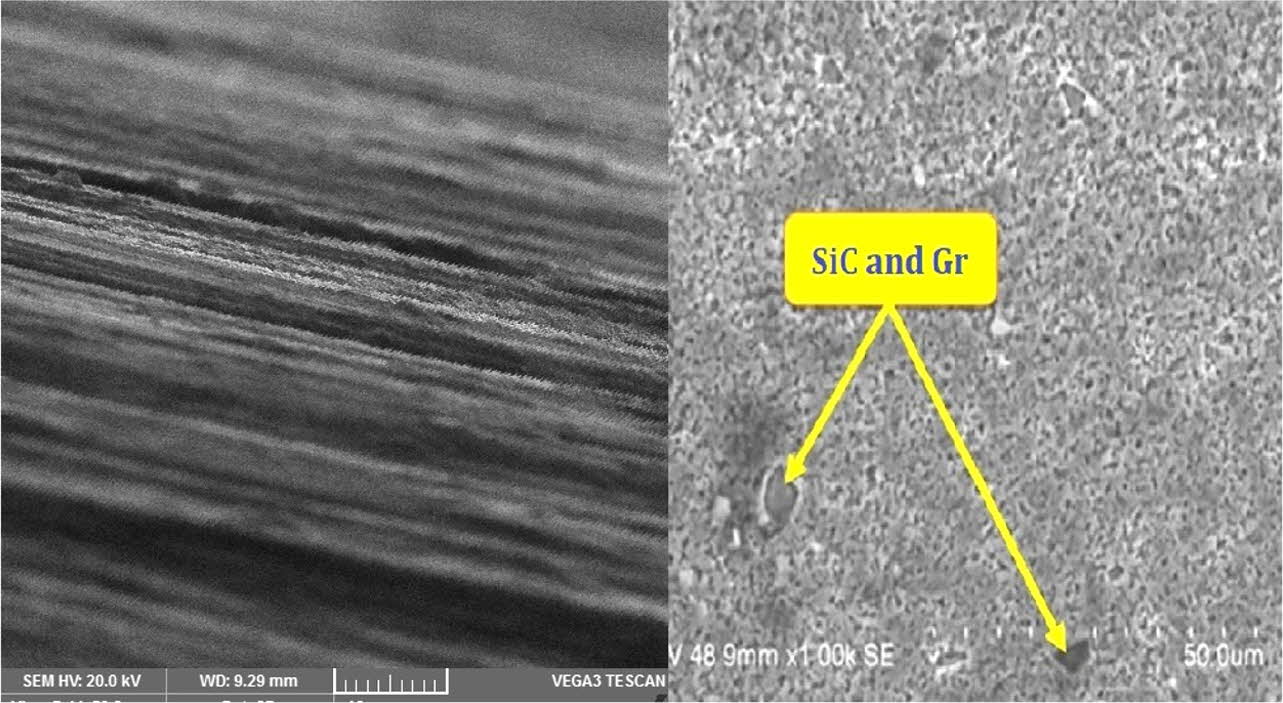
|
Fig. 12 SEM analysis of Confirmation Experiment. |
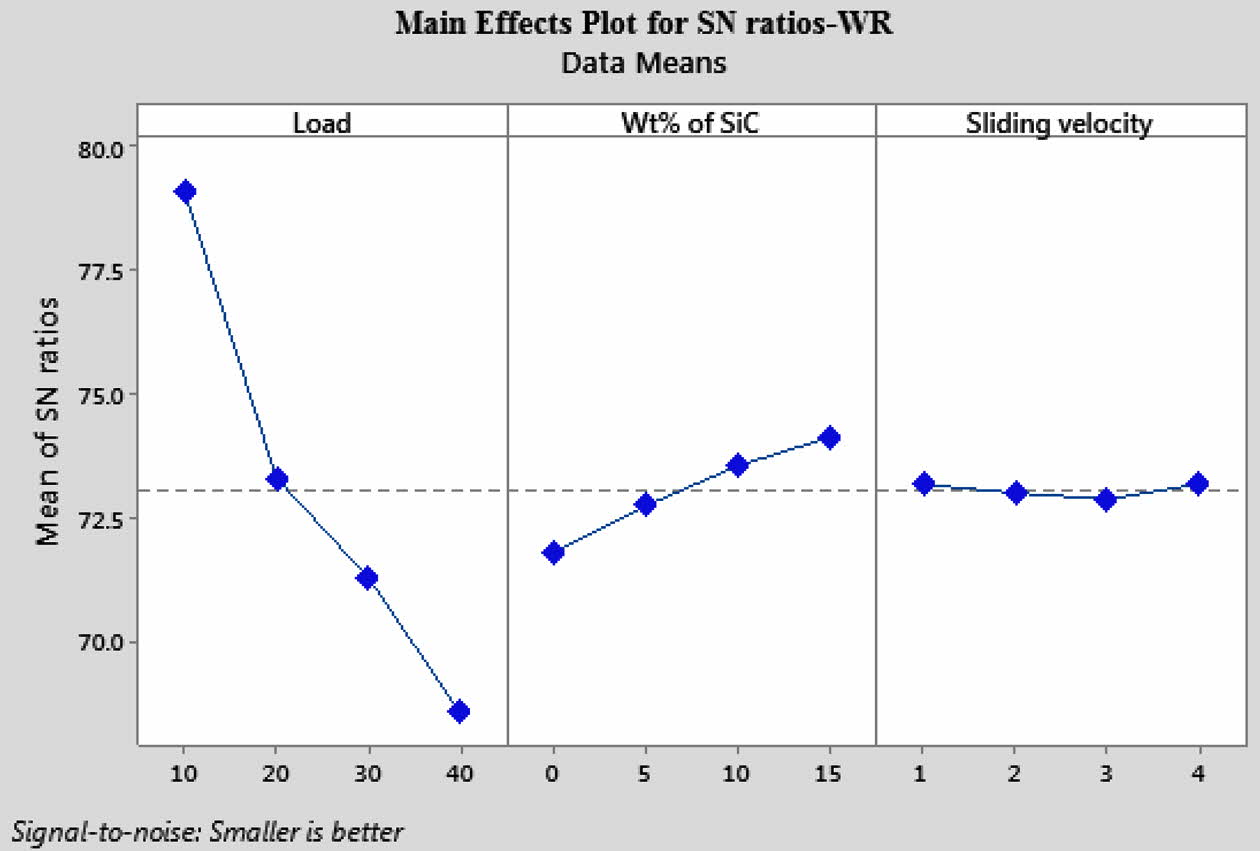
|
Fig. 13 SN ratio plot for WR. |
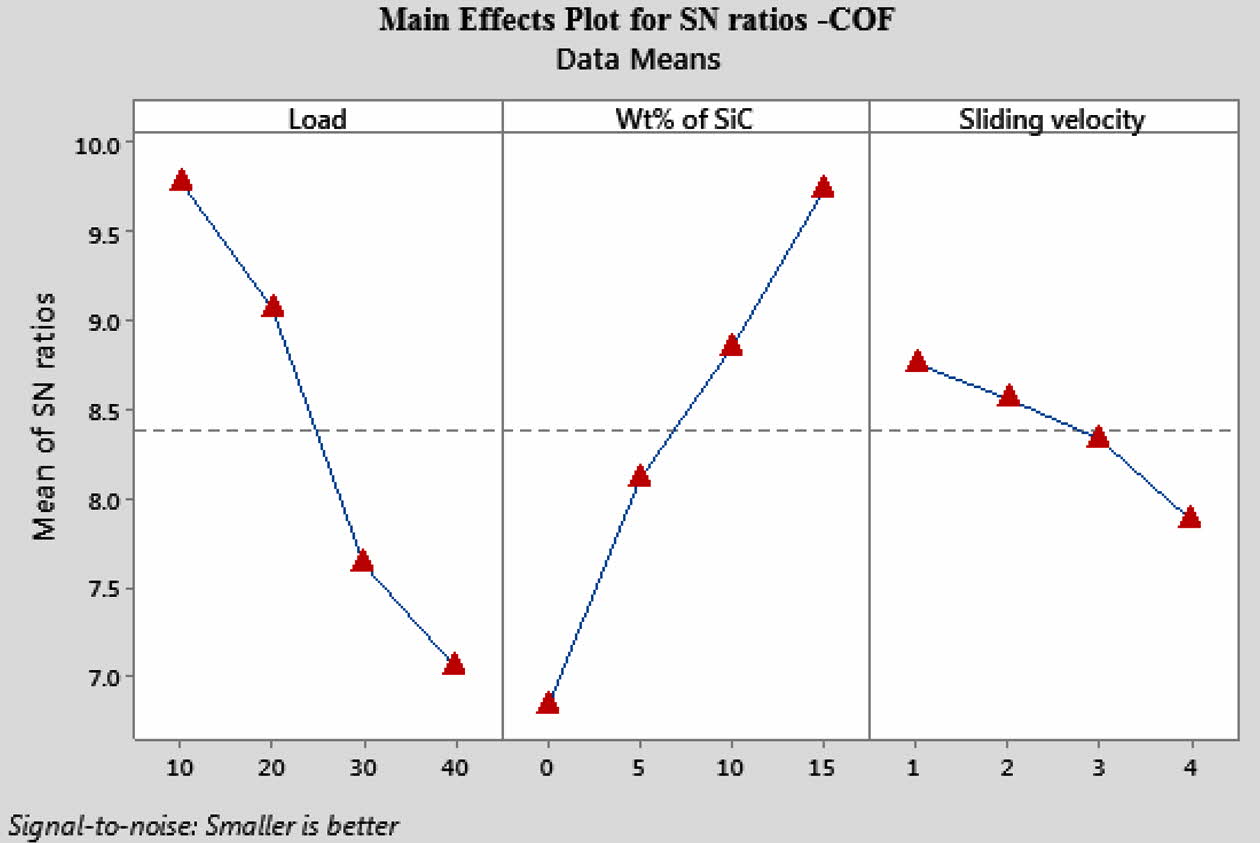
|
Fig. 14 SN ratio plot for COF. |
This research work aimed for Development and mechanical characterization of AA7075 surface hybrid composite with SiC and Gr using Multi pass friction stir processing. Based on the detailed experimental study, the following conclusions were made.
• From the experimental results, it is noted that the micro hardness gradually mounting i.e., 128 HV, 140 HV and 156 HV for 1 pass, 2 pass and 3 pass of AA7075/SiC & Gr respectively.
• The ultimate tensile strength of 3 pass FSP AA7075/ SiC & Gr is 26.12% higher than the base material AA7075.
• The roughness value of 3 pass FSP AA7075/SiC & Gr is reduced up to 78.17%.
• Due to high friction, debris also stayed in the track that results high coefficient of friction in 1 pass and 2 pass FSP AA7075/SiC and Gr surface hybrid composites.
• Based on confirmation experiment, 10 N load, 15 wt.% of SiC, 5 wt. of Gr and 3 m/s Sliding velocity are the optimized parameter for obtaining better 3 pass FSP AA7075 surface hybrid composite.
- 1. G.B. Kumar, C.S.P. Rao, N. Selvaraj, and M.S. Bhagyashekar, J. Miner. Mater. Charact. Eng. 9[1] (2010) 43-55.
-

- 2. J.Q Su, T.W. Nelson, and C.J. Sterling, Philos. Mag. 86[1] (2006) 1-24.
-

- 3. W. Wang, Q. Shi, P. Liu, H. Li, and T. Li, J. Mater. Process. Technol. 209 (2009) 2099-2103.
-

- 4. H.S. Arora, H. Singh, and B.K. Dhindaw, Int. J. Adv. Manuf. Technol. 61 (2012) 1043-1055.
-

- 5. P. Gopi Krishnan, B. Suresh Babu, and K. Siva, J. Ceram. Process. Res. 21[2] (2020) 157-163.
-

- 6. R. Srinivasan, B.S. Babu, P. Prathap, R. Whenish, R. Soundararajan, and G. Chandramohan, J. Ceram. Process. Res. 22[1] (2021) 16-24.
-

- 7. P. Gopi Krishnan, B.S. Babu, S. Madhu, S.J. Gowrishankar, C. Bibin, S. Saran, S. Shree Ram, A.R. Sri Hari and S. Vidyasagar, J. Ceram. Process. Res. 22[5] (2021) 483-489.
-

- 8. K. Periasamy, M. Jayaraman and S. Rajkumar, Int. J. Rapid Manuf. 8[1/2] (2019) 52-64.
-

- 9. P. Kammer, H.K. Shivanand and R.S. Santhosh Kumar, Int. J. Appl. Res. Mech. Eng. 2[3] (2012) 179-183.
-

- 10. A. Baradeswaran, and A. Elaya Perumal, Compos. Part B Eng. 56 (2014) 472-476.
-

- 11. M. Yang, C. Xu C. Wu, K. Lin, Y. J. Chao, and L. An, J. Mater. Sci. 45 (2010) 4431-4438.
-

- 12. P. Asadi, G. Faraji, A. Masoumi and M.K. Besharati Givi, Metall. Mater. Trans. A. 42[9] (2011) 2820-2832.
-

- 13. E.R.I. Mahmouda, M. Takahashi, T. Shibayanagi and K. Ikeuchi, Wear. 268 (2010) 1111-1121.
-

- 14. M.K. Surappa, Sadhana. 28[1&2] (2003) 319-334.
-

- 15. R. Viswanathan, N. Sivashankar, S., Chandrakumar, R., Karthik, Int. J. Mech. Prod. Eng. Res. Dev. 9[3] (2019) 769-774.
- 16. G. B. Veeresh Kumar, C. S. P. Rao, N. Selvaraj, M. S. Bhagyashekar, J. Miner. Mater. Charact. Eng. 9[1] (2010) 43-55.
-

- 17. R. Ramesh and N. Murugan, Int. J. Eng. Adv. Tech. 2[1] (2012) 88-90.
- 18. S. Gopalakannan and T. Senthilvelan, Measurement. 46[8] (2013) 2705-2715.
-

- 19. M.S. Prabhu, A.E. Perumal and S. Arulvel, Surf. Coat. Technol. 394 (2020) 125900
-

- 20. S. Selvakumar, I. Dinaharan, R. Palanivel and B.G. Babu, Mater. Sci. Eng.: A 685 (2017) 317-326.
-

- 21. T. Ye and Y. Xu, J. Ren. Mater. Sci. Eng.: A 753 (2019) 146-155.
-

- 22. X. Cao, Q. Shi, D. Liu, Z. Feng, Q. Liu, and G. Chen, Compo. B Eng. 39 (2018) 97-105.
-

- 23. F. Khodabakhshi, A.P. Gerlich and P. Svec, Materials Characterization. 131 (2017) 359-373.
-

- 24. M.S. Prabhu, A.E. Perumal, S. Arulvel and R.F. Issac, Measurement. 142 (2019)10-20.
-

- 25. P. Kumar, B.P. Vijay Kumar, R. Joshi, T.H. Manjunatha, and R.S. Kumar, Mater. Today: Proc. 5[11] (2018) 25121-25129.
-

- 26. P. Shanmughasundaram and R. Subramanian, J. Mech. Sci. Tech. 27[8] (2013) 2445-2455.
-

- 27. P. Suresh, K. Marimuthu, S. Ranganathan and T. Rajmohan, Trans. Nonferrous Met. Soc. China. 24 (2014) 2805-2814.
-

- 28. L. Krishnamurthy, B.K. Sridhara, D. Abdul Budan, Int. J. Mach. Mach. Mater. 10[1-2] (2011) 137-152.
-

- 29. B. Sadeghi, M. Shamanian, F. Ashrafizadeh, P. Cavaliere, and A. Rizzo, J. Manuf. Process. 32 (2018) 412-24.
-

- 30. T. Thirumalai, R. Subramanian, S. Kumaran, S. Dharmalingam, and S.S. Ramakrishnan, J. Sci. Ind. Res. 73 (2014) 667-670
- 31. Y. Zhang, D. Chern, R. Schulz, J. Mauzeroll, and R.R Chromik, J. Materi. Eng. Perform. 30 (2021) 103-115.
-

- 32. R. Gu, Q. Liu, S. Chen, W. Wang, and X. Wei, J. Mat. Eng. Perform. 28 (2019) 7259-7272.
-

- 33. L. Jinfeng, J. Longtao, W. Gaohui, T. Shoufu, and C. Guoqin, Rare Metal Mat. Eng. 38[11] (2009) 1894-1898.
-

- 34. T. Tamilanban, T.S. Ravikumar, C. Gopinath, and S. Senthilrajan, J. Ceram, Process. Res. 22[6] (2021) 629-635.
-

- 35. R. Crushan and P. Ashoka Varthanan, J. Ceram, Process. Res. 22[6] (2021) 620-628.
-

- 36. P. Muthurasu and M. Kathiresan, J. Ceram, Process. Res. 22[6] (2021) 697-704.
-

- 37. M. Srinivasan, S. Ramesh, S. Sundaram, and R. Viswanathan, J. Ceram, Process. Res. 22[3] (2021) 345-355.
-

- 38. R. Viswanathan and S. Ramesh, in Proceedings of the In- ternational Conference on Advances in Design and Manu- facturing, December 2014, edited by National Institute of Technology Trichy (Bonfring, 2014) p.337-340
 This Article
This Article
-
2022; 23(3): 335-343
Published on Jun 30, 2022
- 10.36410/jcpr.2022.23.3.335
- Received on Dec 21, 2021
- Revised on Jan 20, 2022
- Accepted on Jan 25, 2022
 Services
Services
- Abstract
introduction
materials and methods
result and discussion
parameters optimization
conclusion
- References
- Full Text PDF
Shared
 Correspondence to
Correspondence to
- Periasamy K
-
Department of Mechanical Engineering, Kongunadu College of Engineering and Technology, Trichy, Tamilnadu, India
Tel : +91 9003812232 - E-mail: rk.periyasamy@gmail.com








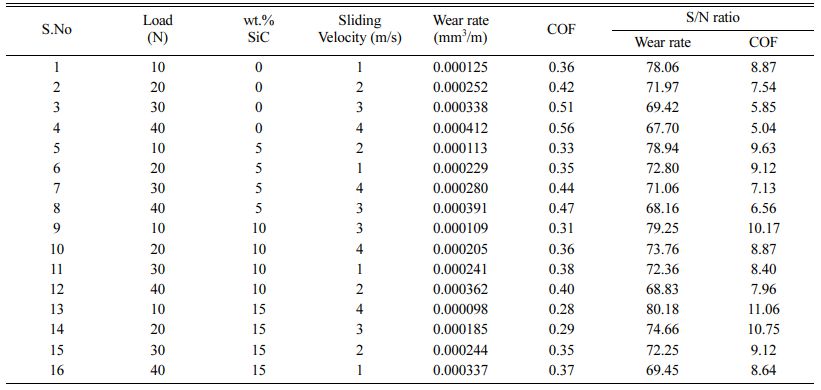
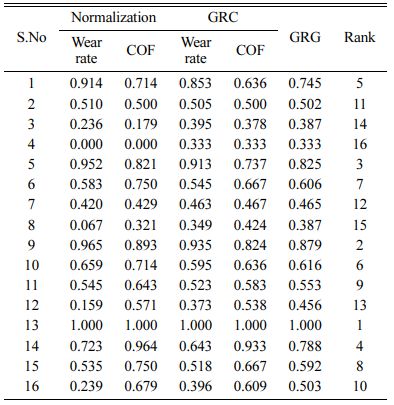
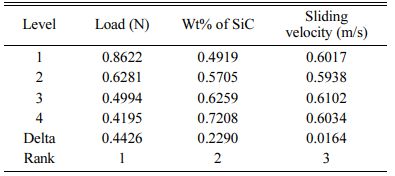

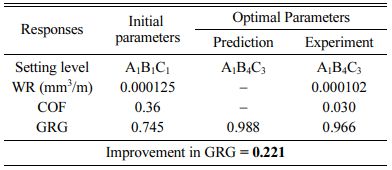
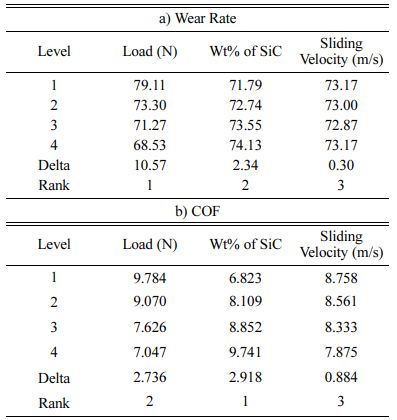
 Copyright 2019 International Orgranization for Ceramic Processing. All rights reserved.
Copyright 2019 International Orgranization for Ceramic Processing. All rights reserved.